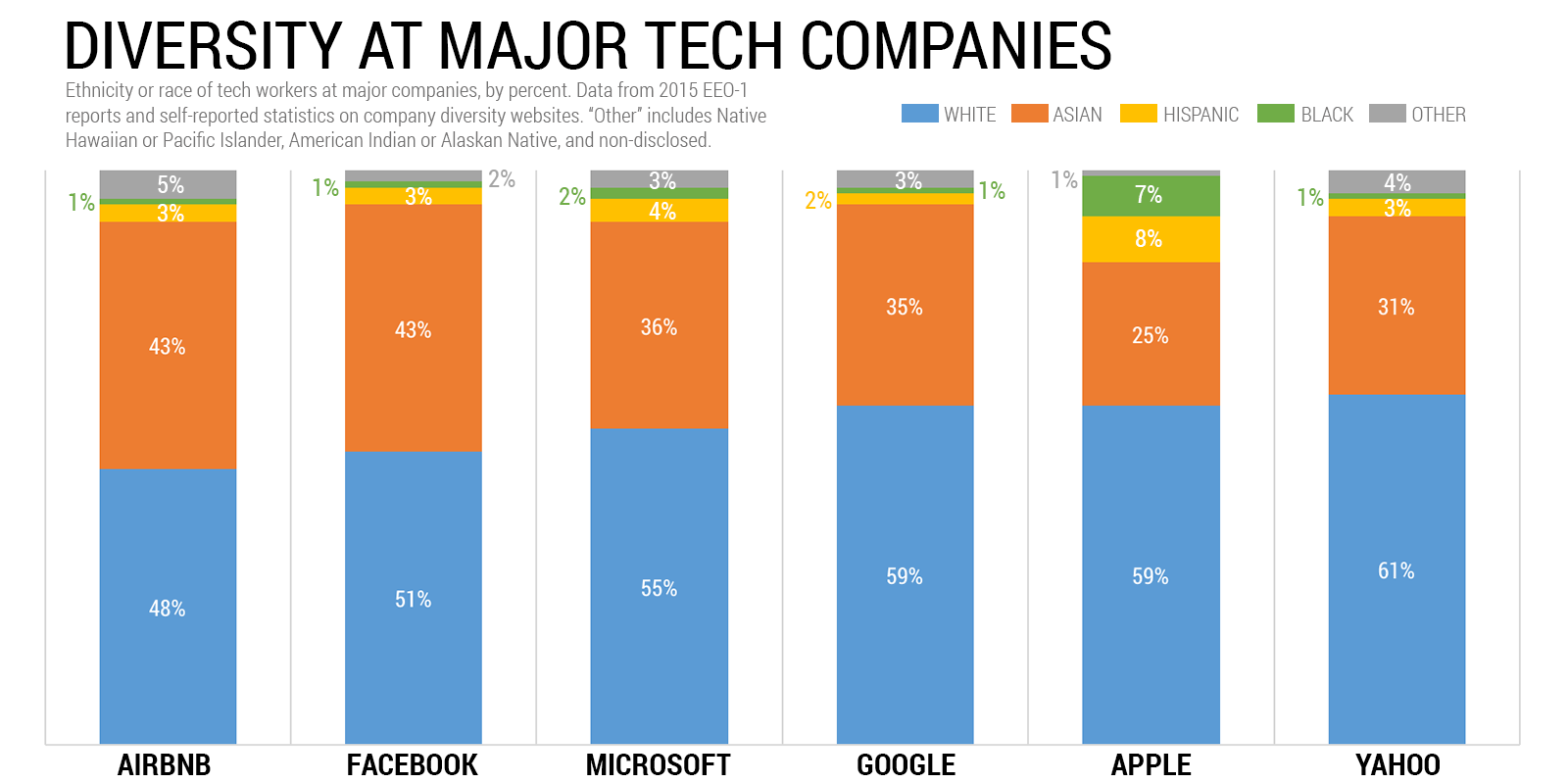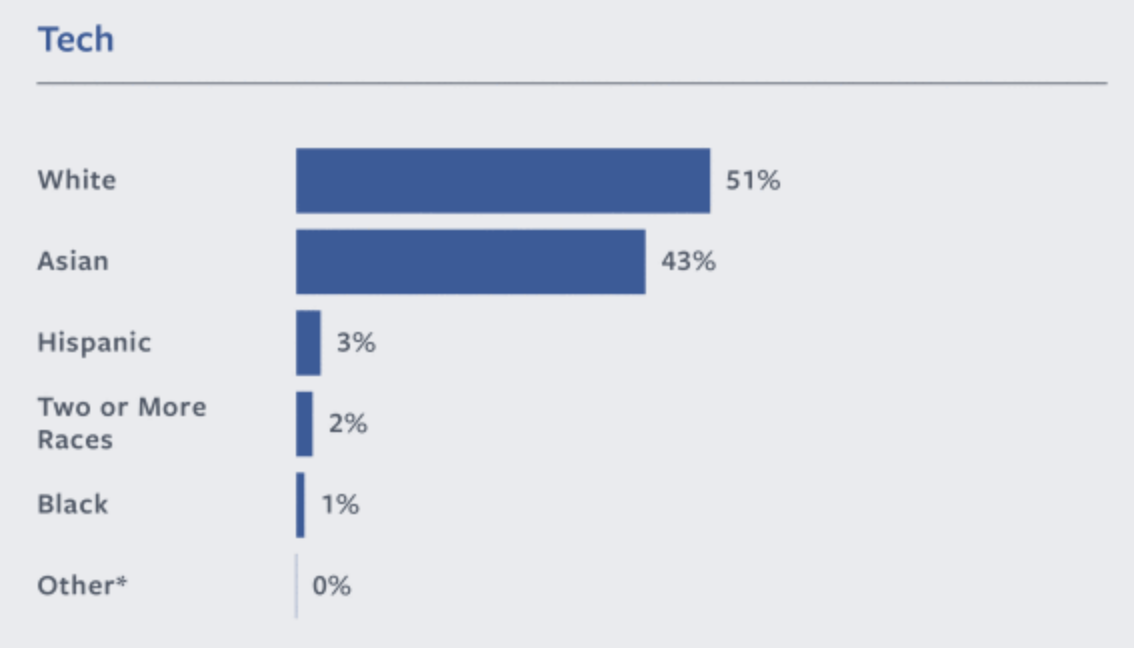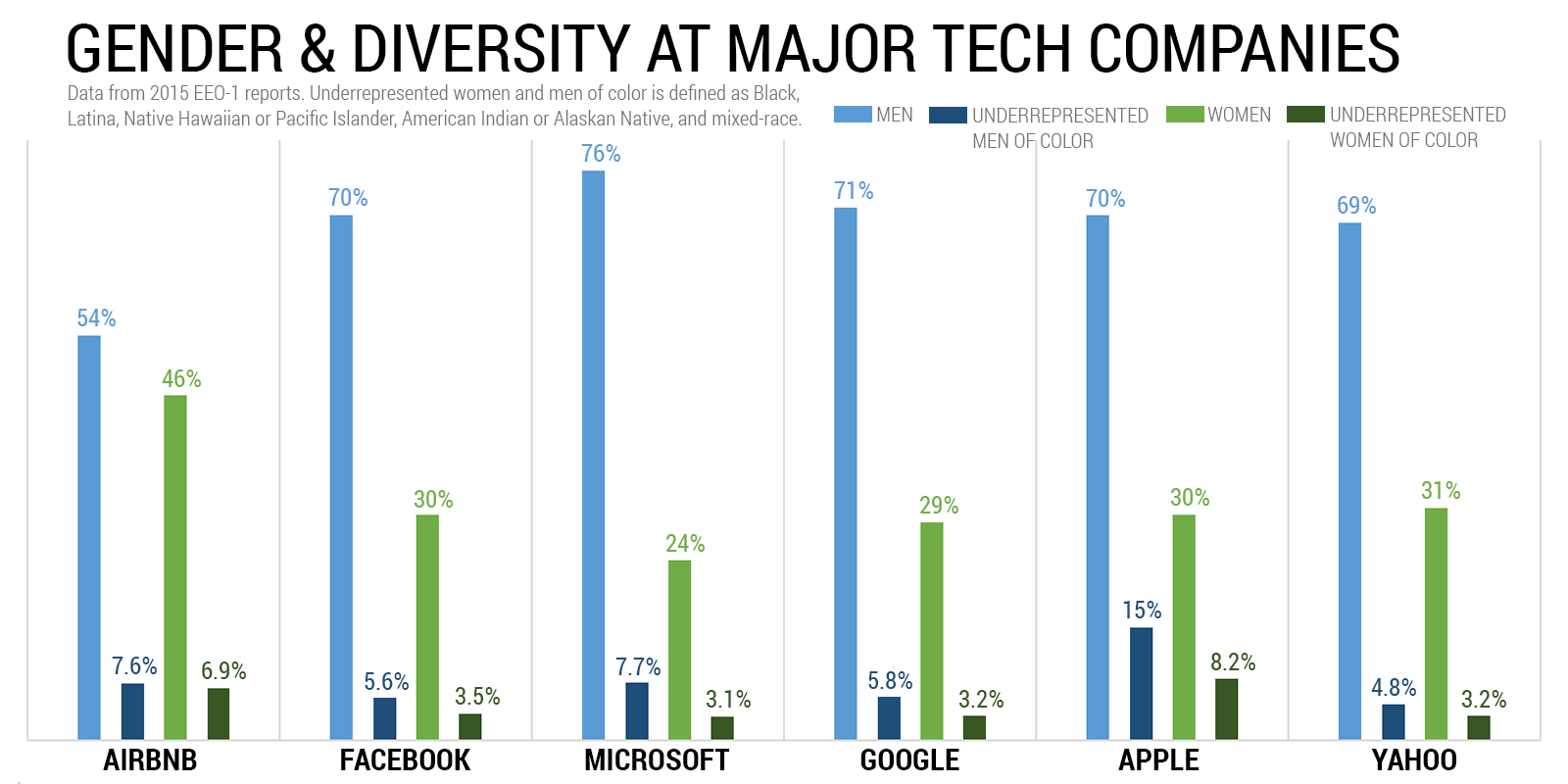The tech industry doesn’t just have a diversity problem. It has a results problem. Major tech companies pour millions of dollars into recruiting, but there remain significant, quantifiable discrepancies — in workforce diversity, in gender equity among people of colour and in representation among top leadership. Even the industry’s annual diversity reports, a crucial step towards transparency, can hide vital information and nuance.
Visualisation: Gizmodo/Angelica Alzona
Tech companies have been disclosing their diversity numbers semi-annually since 2014. In November, Microsoft announced that it would tie executive bonuses to diversity goals after the number of women at the company decreased from 26.8 per cent to 25.8 per cent. Last year, Google donated $US150 million ($205 million) to diversity efforts, and Apple similarly pledged $US50 million ($68 million). But after talking a big game about improving gender and ethnic diversity in their ranks, demonstrated progress has been very slow and, at times, misleading.
To illustrate, we analysed the 2015 diversity data for six companies: Google, Facebook, Yahoo, Microsoft, Airbnb and Apple.

Ethnicity/race for tech workers only. Visualisation: Brittany Schell/Gizmodo. Sources: Airbnb, Facebook, Microsoft, Google, Apple, Yahoo
We used self-reported statistics from 2015, both in the form of percentages from the companies’ diversity landing pages (Airbnb, Facebook, Microsoft, Google, Apple, Yahoo) and official EEO-1 numerical data of employee demographics on file with the US government and available on company websites (Airbnb, Facebook, Microsoft, Google, Apple, Yahoo). We couldn’t include Twitter, which refused to provide its own government diversity filing from 2015.
As you look at these charts, keep the US demographics in mind: 72 per cent white, 16 per cent Hispanic, 12.6 per cent black, 4.8 per cent Asian.
It’s certainly not new that any company struggles with diversifying its tech workforce, though it’s crucial to understand the scope of the problem: A mere one per cent of the tech workers for Facebook, Yahoo, Airbnb and Google are black, a figure that’s been unchanged since the companies started releasing diversity reports. Even the most diverse companies of the six still don’t reflect the ethnic make-up of the country.
Beyond ‘Too Many White People’
In tech positions, Airbnb has the lowest percentage of white workers (48 per cent), but its workforce is not “diverse”. Ninety one per cent of the tech team is white or Asian. Underrepresented people of colour (from black, Hispanic and indigenous communities) are a tiny portion of its workforce.
Apple has more white workers than most tech companies, but many times more black and Hispanic workers. At seven per cent, Apple has more black tech workers than the other five companies combined. Curiously, Apple also has the smallest percentage of Asian workers.
Looking at these companies’ numbers side by side, a strange pattern emerges — the less white a company’s workforce, the more Asian workers it employs (and vice versa). Underrepresented groups generally hover at under 10 per cent. “Diversity” doesn’t mean shifting the balance between two ethnic groups, it means destabilising that pernicious 10 per cent status quo.
The Limitations of Self-Reported Data
Diversity reports are an excellent first step, but they can conceal important details, and companies are making reports public later and later. The EEO-1 filings — raw numbers categorised by race, gender and employee classification — are crucial for scrutinising general demographic data. But specific employee classification — tech workers vs custodial workers vs executive workers — comes from the companies themselves. Companies internally define employees differently from how the government lists EEO-1 categories. An Asian male designated as “professional” on the EEO-1, for example, could be a software developer (meaning they’re “tech”) or a marketing manager (not “tech”).


Facebook Diversity Update: Positive Hiring Trends Show Progress
Instead of releasing the raw numbers that align with how employees are organised internally, most diversity splash pages (which are usually cited in diversity write-ups instead of the EEO-1) offer only percentages. With raw numerical data, we’d have a much clearer picture of the myriad diversity issues beyond general demographics. We’d be able to see the race/gender breakdown of new hires, the promotion frequency of women in specific fields and so on.
One group, women of colour, are particularly disadvantaged by the way companies release data. Race and gender are recorded separately. Only the raw data of the EEO-1 allows for intersectional approaches to analysis. Ideally, companies would release raw numbers and information on how it organises candidates internally. For now, we’re limited to little more than what we’re given. And obviously, it isn’t enough.
Race and Gender, at the Same Damn Time
Women are far outnumbered by men at these companies. But when tech companies focus on recruiting more women, that usually results in more white women.

Gender demographics for all US workers. Visualisation: Brittany Schell/Gizmodo. Sources: Airbnb, Facebook, Microsoft, Google, Apple, Yahoo
Women overall make up roughly a third of these companies, with Microsoft lagging behind. Underrepresented women of colour (defined in the EEO-1 data as black, Latina, Native Hawaiian or Pacific Islander, American Indian or Alaskan Native or mixed-race) are a small fraction of that: Usually about three per cent. Underrepresented men fare better than women in all companies, though Airbnb is the closest to achieving gender equity among underrepresented groups. Apple, again, has much higher percentages of underrepresented groups, but is also the most skewed in balancing gender.
Too many diversity initiatives focus on either race or gender, ignoring the specific issues women of colour face, even after they’re hired. For example, being mistaken for custodial or administrative staff — which, horrifyingly, happened to almost half of the black and Latina women in STEM surveyed by the Harvard Business Review.
Having so few workers of colour can be isolating. For underrepresented workers, it can make the possibility of failing terrifying. When Pinterest’s CEO met with the company’s black software developers, according to Candice Morgan, Pinterest’s diversity head who spoke about the issue at a tech event in November, the software developers told him they bore a “sense of the weight of the entire race on [their] performance”. Being the “only” — the only woman, the only person of colour, the only person not from an Ivy — is stifling and can make growth seem impossible.
Going Beyond Recruitment
The other problem, say diversity advocates, is that once you do break into the tech ranks, it’s hard to climb them.
“When they hire these people from colleges, they leave them at the bottom of their organisation,” said Erica Joy Baker, a diversity advocate and Slack engineer, at a recent tech event in San Francisco. “And suddenly, you see all the people of colour, all the marginalised people at the bottom… you don’t see them rising to the top level, the executives [or] board members.”
This definition of “underrepresented” doesn’t include Asian workers because they make up such a large portion of both the tech and overall workforce at these companies. But, this classification obscures a serious barrier to success for Asian workers.

Race of entire company vs. Leadership. Visualisation: Brittany Schell/Gizmodo. Sources: Airbnb, Facebook, Microsoft, Google, Apple, Yahoo
Coined by Jane Hyun in 2005, the “bamboo ceiling” refers to the discriminatory phenomenon in which Asian workers are well-represented as employees, but cluster in professional and middle management positions, unable to reach the upper rungs of the company. As the numbers show, that’s still in full effect more than 10 years later.
Yahoo stands out as being particularly guilty of this: Asian workers are 44 per cent of overall staff but only 19 per cent of senior positions. Meanwhile, white workers are 48 per cent of staff and 73 per cent of senior execs.
Apple and Airbnb both have nearly equal representation for Asian workers in leadership, but again, diversity is not simply shifting the balance between white and Asian, it’s destabilising that < 10 per cent barrier for everyone else.
Talking Loud and Saying Nothing
There’s no doubt that important progress has been made. We’re seeing the beginnings of ongoing, industry-wide conversations. Those few percentage points are meagre, but they represent hundreds of jobs and hundreds of new connections, networks and opportunities for people to build, innovate and discover new approaches to technology. Women and people of colour are not the only ones who benefit from diversity — everyone does.
Every step in this direction is monumental, but we can’t allow for stagnancy. We can’t uncritically accept or applaud minor progress as the norm. For once, I agree with this obnoxious, overused company maxim: Diversity is important, but we shouldn’t lower the bar. We should push for more.
